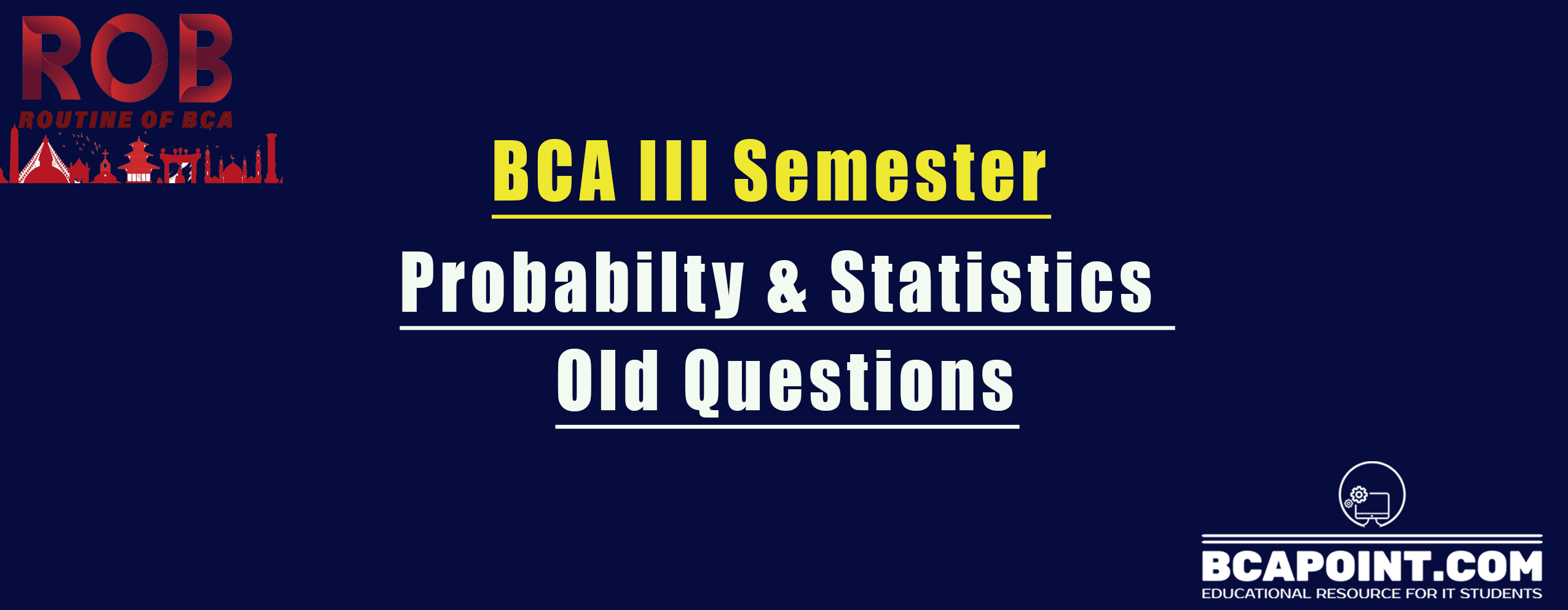BCA Third Semester old Question Probability and Statistics
Group B
Attempt any Six question
2. Write down the process of collecting Primary data
3. Determine first quartile (Q1) 7th Decile (D7) and 80th Percentile (P80) from the following data:
| Age in Year | 10 | 12 | 14 | 16 | 18 | 20 | 22 | 24 | 26 |
| No. of People | 2 | 11 | 24 | 35 | 27 | 17 | 11 | 8 | 5 |
4. Calculate correlation coefficient between income and expenditure in foods of certain families of Kathmandu Metropolitan from the following information
| Income (000 Rs) | 10 | 11 | 12 | 13 | 14 |
| Expenditure in food (000Rs) | 9 | 8 | 9 | 12 | 11 |
5. A box contain 50 item of which 20 are defectives. If one item is selected randomly from the box, what is the probability that it is a non-defective item?
6. What is sampling? The Standard Deviation of marks in an entrance exam in BCA students is 0.5. How large a sample must be taken in oder to be 95% confidence that the error of his/her estimate will not exceed 0.01.
7. Calculate the median and mode from following distribution
| Expenditure (000Rs) | 10 – 20 | 20 – 30 | 30 – 40 | 40 – 50 | 50 – 60 | 60 – 70 |
| Number in families | 7 | 12 | 15 | 13 | 8 | 5 |
8. A test was given to three candidates taken at random from three province of Nepal. the scores of candidates are given below:
| Gandaki | 9 | 7 | 6 |
| Lumbini | 7 | 4 | 5 |
| Bagmati | 6 | 5 | 6 |
Carry out one-way ANOVA
Group C
Attempt any two questions
9. From the following data, determine average marks of student, standard deviation and coefficient variation
| Marks | 0 – 10 | 10 – 20 | 20 – 30 | 30 – 40 | 40 – 50 | 50 – 60 | 60 – 70 | 70 – 80 | 80 – 90 |
| No of people | 54 | 90 | 86 | 58 | 62 | 82 | 78 | 66 | 70 |
10. Describe simple random sampling with suitable example.
BCA Third Semester old Question Probability and Statistics 2019
Group B
Attempt any Six question
2. Describe scope and limitation of statistics.
3. Determine average wages from following data:
| Wage | 25 – 30 | 30 – 35 | 35 – 40 | 40 – 45 | 45 – 50 | 50 – 55 | 55 – 60 | 60 – 65 | 65 – 70 |
| No of worker | 10 | 13 | 18 | 21 | 24 | 28 | 20 | 11 | 8 |
4. Calculate Karl Pearson’s correlation coefficient from the following data:
| Sales | 43 | 41 | 36 | 34 | 50 |
| Expenses | 10 | 22 | 13 | 19 | 17 |
5. Estimate the marks in JAVA when the marks in statistics in 65 by using following data.
| Marks in statistics | 57 | 58 | 59 | 59 | 60 | 61 | 62 | 64 |
| Expenses | 77 | 78 | 75 | 78 | 82 | 82 | 79 | 81 |
6. Fit Bionomial Distribution from the following data where p = 0.5
| No. of health | 0 | 1 | 2 | 3 | 4 |
| Frequency | 28 | 62 | 46 | 20 | 4 |
7. How do you determine sample size in sampling? explain briefly
8. Write short notes on simple random sampling.
(Do follow us for updates Routine of BCA)
Group C
Attempt any Two question
9. Student’s age in the regular daytime BCCA program and the morning time BCA program of campus are described by two samples. If the homogeneity in age of the class is positive factor in learning make suggestions, with reason which of two groups will be easier to teach
| Popular BCA Program | Morning BCA Program | ||
| Age | Number of student | Age | Number of student |
| 23 | 9 | 27 | 19 |
| 29 | 2 | 31 | 8 |
| 28 | 5 | 30 | 5 |
| 22 | 10 | 29 | 4 |
| 30 | 1 | 28 | 6 |
| 21 | 4 | 33 | 5 |
| 25 | 11 | 34 | 5 |
| 26 | 6 | 35 | 11 |
| 27 | 3 | 36 | 2 |
| 24 | 9 | 32 | 4 |
| Total | 60 | Total | 60 |
10. The labor productivity indexes of Nepal are recorded is below:
| Sector | Year | ||
| 2015 | 2016 | 2017 | |
| Agriculture | 100 | 125 | 138 |
| Manufacturing | 100 | 60 | 53 |
| Community and social service | 100 | 89 | 80 |
Does the labor productivity index vary die to the;
i) Difference in the sector
ii) Difference in the time period
Click for: Old questions of OOP in Java


